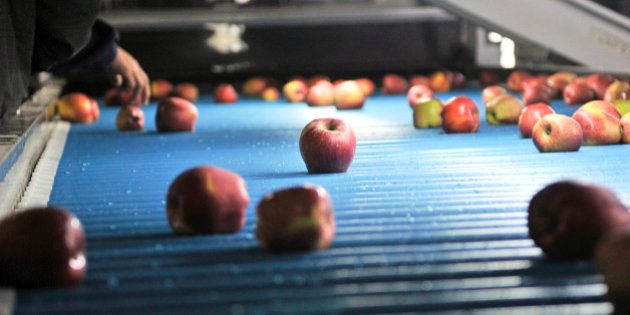
In ancient Indian lore, there were rishis and rishikas, men and women known to do penance for extended periods. A weakness of the body disturbed their concentration... it could not survive without water and food for longer than a week or so. To resolve this bother, they would climb atop the Himalayas and strip off their garments before entering their meditative stage. They had learnt that exposure to the chilling cold reduced bodily demands, thereby letting their mind remain longer at whatever they were contemplating. Effectively, they had bought extra time, for multiple weeks, their body literally living only on fresh air, for far longer than is normally possible. They used the cold effectively to meet their end goal.
Here, I'd like you to spend time contemplating the cold too. Or more specifically, the importance of the cold chain in the fruit and veggie supply mechanism.
Food has one end-use--to be consumed. Food loss or waste occurs when food is not consumed or when it perishes before reaching the market within its normal saleable life cycle.

Food loss can be reduced by ensuring that all the harvested produce reaches its intended end-use. This means that food delivery mechanisms must also aim to counter the perishable nature of food, to extend its saleable life cycle. Cold-chain is the mechanism that does this.
Cold-chain does not preserve endlessly. It applies technology to merely stretch the marketable time of a perishable product, for a very finite duration. This or any time in hand should be fruitfully utilized and not wasted in-situ storage, especially when dealing with high perishable fresh produce.
Cold-chain buys time by temporarily countering perishability. This allows produce owners more time to reach buyers, to expand their market footprint to realise greater economic value. In turn, this promotes gainful livelihood and justifies any efforts to increase production.
Saleable life extension is best utilised by moving to markets, reaching closer to the shelf and the consumers who complete the cycle. Food lost in the delivery chain is avoidable loss, and loss in the hands of consumers is called waste.
Cold stores do not directly reduce food loss. They are only one piece in the cold-chain. All inventories have a time limitation--even grain perishes if left in storage.
Supply chain intervention is best used to reach more shelves and increase access to more buyers. This logic applies to all products. The time matrix is determined by the saleable life span of the product and time taken to access markets.
Physical loss of food has a multiplier effect in associated waste of inputs. Six apples lost means loss of >500 litres of the water used to produce them, a dozen tomatoes equals >200 litres of water. Add to this the power, fertilizer, etc. The total loss has a huge impact on our ecological footprints.
Food loss adds needlessly to greenhouse emissions, contributing to climate change. The answer is to bring what is produced to gainful end-use.
Cold-chain is a logistics tool, a service that uses cooling and other techniques, to make it feasible to access multiple markets--taking perishable produce where it could not normally have reached.
Understand cold-chain as a bridge, not merely as a storage system. When used as a physical conduit to markets, cold-chain is always successful as it then expands the geographical reach of producers, and by reaching more consumers provides real cause to produce more at farms.
Without market access, all food will eventually perish, unused-- lost even when stored within temperature controlled environs. Hence, cold-chain is a solution only when used to facilitate market access, to reach many more consumers.
Cold-chain is a logistics tool, a service that uses cooling and other techniques, to make it feasible to access multiple markets--taking perishable produce where it could not normally have reached.
Refrigeration brings intrinsic challenges in fresh produce care, which when not understood can make its application the premier cause for food loss. Cold-chain is not just about cooling, but includes specialised post-harvest handling in the supply chain of fresh produce. Cold-chain also helps to organize the business of agriculture.
India's cold-chain successes are many, including being among the top 10 exporters of fresh grapes; in having the world's largest dairy production and consumption; in being amongst the largest exporters of poultry and eggs, etc.
Failures in cold-chain are where it remained fledgling, misunderstood--namely, the domestic trade of various fresh fruits and vegetables. This area needs multi-disciplinary skills akin to life care--knowledge of biology, physics, logistics and time management, not of refrigeration alone. Without feasible market links, in this sector the loss is large. Due to perishability, time, range and access to consumers is limited, and after a short period, all that remains unsold perishes. Luckily, some of the would-be-loss of fresh produce can be processed into food products.
Food processing, though it also may use temperature controlled technologies, is to be differentiated from cold-supply-chain. It is essentially a manufacturing process that transforms raw whole produce into other food formats. However, it involves adding resources anew in a second production phase and not merely in the delivery system.
Processing is an option typically pursued when all alternatives to deliver fresh have been exhausted or are not possible. Food processing is best when extracting value from non-table variety fresh produce, or wherein culled produce is transformed into food products, mixtures or ingredients. Non-food processing--composting, dye making, medicinal formulations--is another end-use that also helps recover agriculture losses.
Food loss is not just related to a food crisis but lends to an ecological crisis.



Contact HuffPost India
Also see on HuffPost:
